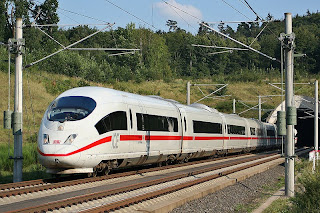Everyone saw it on Tuesday; like a white slug, a Deutsche Bahn ICE3 train rolled into St Pancras, signalling the company’s long-planned intention to run services from London to destinations throughout Europe from 2013. This is just what I wanted to see; better use of the under-used channel tunnel. Yet, poor old DB had been clearly upstaged. Just 11 days before Eurostar, the current operator of trains between St Pancras and the continent, announced the purchase of ten new trains from Siemens that will run between Britain and European destinations, and which will be delivered in 2014. And so, with much fanfare, a mock-up of one of the trains’ new power cars was placed next to the Albert Memorial in Kensington Gardens.
In essence, these new trains evidence that a ‘race to Europe,’ a name with which I now dub DB and theirs burgeoning competition, is in the offing. Indeed, DB have stated that trains will be run to and from Amsterdam, Rotterdam, Frankfurt and Cologne, whereas Eurostar haven’t specified yet exactly what their destinations will be; a move to probably keep their competitor guessing. So it is possible that Eurostar may run to those places also.
Races to places by train are always exciting. In the 1930s two railway companies, the London and North Eastern (LNER) and London Midland and Scottish Railways (LMS), poured millions of pounds into the second ‘race to the north.’ This was a competition between the two companies, who both served Scotland, to attract passenger traffic through the use of speed, style and comfort. Both companies subsequently developed streamlined locomotives to push the speed of their services up, as well as built some of the most luxurious coaches ever seen on the British railway network.
The problem with the whole enterprise was that the LNER and LMS didn’t really need to engage in this competition. Both had a monopoly on their particular routes, apart from when trains hit Scotland, and both companies did not derive most of their revenue from passenger traffic. Yet, freight revenue, which was their main earner, was suffering by the 1930s. Firstly, government regulation restricted what they could charge for goods haulage; but also, much of their goods business was being lost to road hauliers. Thus, both companies would have better served their interests by not investing the competition, and instead putting the majority of their developmental efforts into improving their goods services, both in cooperation with each other and individually.
Therefore, if we are going to experience a new railway race, if Europe is the place where this battle is to be made fought, then BD and Eurostar have to address beforehand the question as to whether they actually need to compete at all. There are enough attractive destinations in Europe which they could serve, and as such the companies could choose to run trains to different destinations. Of course, some might say that competition to destinations will be good for the customer, as prices will be driven down and the quality of travel will increase as the companies try and tempt passengers. But if all the London to Europe trains go to the same places it won’t be good for the British passenger, as the companies’ could have taken decisions that would have increased the destinations available. Therefore, it is in our interest as passengers that DB and Eurostar work together on destinations before they start to compete.
Tidak ada komentar:
Posting Komentar